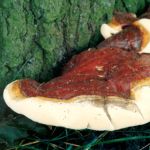| Common Name: |
Laquered Bracket Fungus |
| Other Names: |
Reishi |
| Botanical Name: |
Ganoderma lucidum |
| Genus: |
Ganoderma |
| Family: |
Polyporaceae |
| Native Location: |
Warm and temperate regions |
| Cultivation: |
On living or dead wood of deciduous trees, often Quercus spp. (See, oak), often near the base. |
| Propagation: |
By spores. |
| Harvest: |
Fungi are collected when mature and sun-dried for use in syrups, powders, tablets, and tinctures. |
| Height: |
15-30cm (6-12in) |
| Width: |
15-30cm (6-12in) |
| Hardiness: |
Z4-10 |
| Parts Used: |
Whole plant (ling zhi). |
| Properties: |
A tonic, sedative herb that is expectorant, lowers blood sugar and cholesterol levels, controls coughing, relieves pain, and stimulates the immune system. It improves heart and liver function, and has anti-allergenic, antiviral, and anti-bacterial effects. |
| Medicinal Uses: |
Internally for bronchitis, asthma, liver disorders, rheumatoid arthritis, heart disease, palpitations, high blood pressure, high cholesterol levels, nervous disorders, insomnia, and debility. |
| Culinary Uses: |
Extracts are made into a tonic candy. |
| Bibliography: |
Encyclopedia of Herbs by Deni Bown Copyright ©: 1995, 2005 Dorling Kindersley Limited, pp.219-220
|

